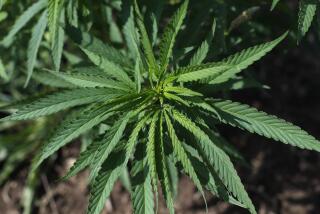Hemp’s Profile Getting Higher but Marijuana Factor Still a Bummer
- Share via
WOLF CREEK, Ore. — In the woods of southern Oregon, where deputies in camouflaged fatigues beat the brush each fall for hidden marijuana plantations, Kevyn Woven strings his loom with the straight cousin of the pot plant: industrial hemp.
Using hemp fiber and yarn imported from Poland, Romania and China, where cultivation and sale of industrial hemp is legal, Woven creates rich, nubby fabrics in woodland colors that wind up as boutique clothing and upholstery on custom-made furniture in luxury homes.
“It is my passion,” said Woven, who is as eager to extol the many virtues of hemp as he is to sell his fabrics.
Once sold primarily at hippie fairs and through ads in the back pages of magazines with an environmental bent, goods made from industrial hemp are moving into the mainstream. Adidas used it in a shoe, the Body Shop features a line of hemp cosmetics at its store on New York’s Fifth Avenue, and European car makers use it in interiors. There’s even a beer made with it.
“I feel the industrial hemp crop could very easily be the soybean crop of the new millennium,” said Jeffrey W. Gain, a former farm lobbyist who is chairman of the U.S. Department of Agriculture’s Alternative Agricultural Research and Commercialization Corp.
Like soybeans, hemp produces an oil from its seeds that can be turned into cooking oil, cosmetics and plastics. Hemp fiber can be used to make paper, cloth and even structural panels stronger than plywood. The seed can be ground for flour and livestock seed.
Growing hemp in rotation with cotton and other crops increases their yields and reduces the need for pesticides.
“It’s really an amazing crop,” Gain said.
DEA Just Says No to Hemp
Industrial hemp is the same species as marijuana, Cannabis sativa, but it is a different variety which, due to genetics and growing practices, has only a very small amount of tetrahydrocannabinol, or THC, the stuff that makes pot smokers high.
But even that small amount, less than 1%, is enough to make it an outlaw in the eyes of Gen. Barry McCaffrey, the U.S. drug czar who heads the White House Office of National Drug Control Policy. He contends that efforts to legalize hemp are a smoke screen to legalize marijuana.
“A serious law enforcement concern is that a potential byproduct of legalizing hemp production would be de facto legalization of marijuana cultivation,” McCaffrey’s office said in a statement. “The seedlings are the same and in many instances the mature plants look the same.”
Hogwash, say hemp advocates. The 29 countries that allow farmers to grow hemp, including Canada, France, Germany and England, are able to work around the differences. And the thought of cross-pollination with low-THC hemp makes pot growers cringe.
Indeed, hemp was a strategic crop until the turn of the century, when steam power took over for sail on ships, said John Roulac, author of Hemp Horizons and founder of HEMPTECH, a hemp information network.
“Old Ironsides,” the USS Constitution, went into battle with sails, rigging and caulking made from it. Founding fathers George Washington and Thomas Jefferson grew it. The Declaration of Independence was drafted on paper made from it. Farmers could pay their taxes with it.
The invention of the cotton gin in 1793 spawned the rise of cotton as the world’s dominant fiber, though it was shorter, weaker and rotted more easily than hemp.
The coup de grace came from the Marijuana Tax Act of 1937. Though it allowed farmers to continue growing hemp, the government wouldn’t issue permits for them to ship their crops to processing plants because a few leaves that might contain THC were left on the stalks, Roulac said. By the end of 1938, every hemp factory in the Midwest was shut down, except one with a contract to supply rope to the Navy.
There was a brief resurgence during World War II, when the federal government launched a “Hemp for Victory” campaign for rope and parachute cord, but after the war, hemp was an outlaw again.
Med Byrd, director of applied research at North Carolina State University, sees hemp as part of the mix of plants--including wheat and rice straw and kenaf--that will fill the growing global demand for fiber.
“There are signs the world could be facing a significant fiber shortage early in the 21st century,” Byrd said. “One way of looking at this is that there are about a billion people in China. Each person in the United States uses about 700 pounds of paper per year. In a developing country like China, the figure is closer to seven pounds.
“Let’s say the proper number for a well-educated society is 300 pounds of paper per person per year. Take the difference between the Chinese figure of seven pounds and the proper figure of 300 pounds--293 pounds--and multiply by a billion. We don’t know where that fiber is going to come from.”
As a source of paper, hemp is tough to work with, because its fibers are longer than the wood fibers that the nation’s pulp plants are set up for. But one big advantage is that hemp grows much faster than trees, which is an important factor when you are playing catch-up, Byrd said.
While the DEA argues that hemp is much more expensive than other fibers, hemp advocates point out that difference would drop immediately if hemp didn’t have to be imported from Europe and China. Canada decided to let farmers begin planting 5,000 acres this year.
“As long as McCaffrey is there it’s probably not going to happen,” in the United States, said Gain, who is also on the board of the North American Industrial Hemp Assn. He said all it would take to begin producing hemp in this country is for the DEA and the president to sign off on it.
Farmers Revolt Against Hemp Ban
But the Kentucky Hemp Growers Cooperative, the Hemp Co. of America and six would-be hemp farmers aren’t waiting. They sued the DEA and the U.S. Justice Department last May. They contend that Congress never intended to make industrial hemp illegal when it outlawed marijuana.
Faced with growing uncertainty for the future of tobacco farmers because of federal efforts to wipe out smoking, the University of Kentucky’s Center for Business and Economic Research looked into the prospects of growing hemp, once one of the state’s biggest crops.
The study found that hemp could earn farmers $220 an acre when grown from straw and grain, and up to $600 an acre when grown for certified seed. That would make it the second most profitable cash crop in the state after tobacco, which brings in $1,000 to $1,500 per acre.
“It is moving from the fringe, but it is still very boutique,” Byrd said. “Anybody who’s got enough money can buy hemp products. You can buy hemp oil, hemp lip balm, hemp beer, hemp this, hemp that.
“If enough fringe people buy those products, and enough people work on processes to get the price down and enough farmers are allowed to grow it, all that can change.”
More to Read
Inside the business of entertainment
The Wide Shot brings you news, analysis and insights on everything from streaming wars to production — and what it all means for the future.
You may occasionally receive promotional content from the Los Angeles Times.










